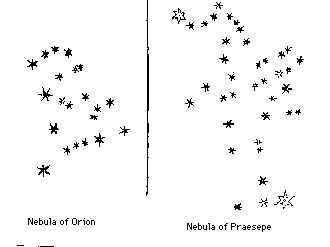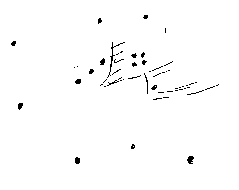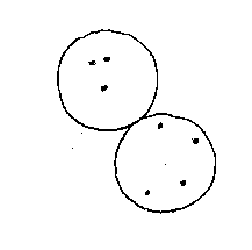
In a short segment of Galileo's book Sidereus Nuncius, Galileo briefly examined recent observations he had made on the realm of the fixed stars. Through the telescope, Galileo was able to see stars that, before this time, were not even known to exist. These stars, stars below what Galileo called the sixth magnitude, appeared as bright using the telescope as the second magnitude of stars appeared as seen through natural vision. (Galileo used the term magnitude in describing the brightness of the stars seen without use of any visual aids.)
Galileo decided to demonstrate the great number of stars that actually existed by depicting a few star systems that were known to all and including the additional stars that he had observed. He chose to depict the entire constellations of Orion and the Pleiades, but soon decided that Orion was just too large, and so he only sketched the belt and sword region of Orion. Below are the drawings Galileo made of Orion and the Pleiades as put forth in his publication Sidereus Nuncius, pages 60 and 61.
Galileo identified the known stars in his depiction by making them larger and surrounding them with an outline.
Galileo was very interested in these previously "invisible" stars because he felt they were critical to understanding nebulae and the Milky Way. Galileo thought that what had previously been seen as a milky luster in the sky was no more than than these invisible stars. The Milky Way then was just the view of these far distant stars from earth. Nebulae or nebulous stars were in fact actually a number of small stars clustered together. Galileo went on to prove this assertion by sketching out two "nebulae" which were indeed clusters of stars. He depicted the Orion's Head nebula and the nebula of Praesepe (located in the Cancer constellation) which are shown below. The pictures are from Sidereus Nuncius on page 63.

Galileo was accurate in some of his assessments about what were then considered nebulae and about the Milky Way. Galileo was correct in concluding that the Milky Way was composed of stars, he just had not realized that it could also include gas and dust. He made this same error in his conclusions about nebulae. Many of the areas of sky that had been considered nebulae before Galileo's time were actually start clusters. Galileo was correct then, for some objects, in declaring that the nebulae of the time were actually composed of distant stars. Galileo did not come to the realization however that true nebulae could and did also exist. A true nebula is a cloud that is composed of gas and dust and appears hazy. It is not composed of far distant starts that could be differentiated had we only sufficiently powerful equipment.
One such true nebula is the Orion Nebula which is located in the sword of Orion. This nebula is conspiciously absent from Galileo's drawing of Orion. There are a number of possible reasons that Galileo could have missed the Orion nebula in his observations. The first is that he just did not see it with his telescope. This possibility is highly unlikely as the Orion nebula is visible through the most simple telescopes and binoculars. Another possibility is that, due to the limited field of view of Galileo's telescope, he did not notice the hazy quality of the sky in the area of the nebula as being extremely different from the sky around it. This is another unlikely scenario as the nebula should have been fairly noticeable through Galileo's telescope and as we shall see in the Pleiades diagram later on, the field of view was sufficient for viewing a few stars at a time. This telescope then, should have be sufficient to view the Orion Nebula. The last and most probable possibility is that Galileo knew the nebula existed, but was unable to distinguish the nebula into stars and thus ignored it. This possibility does not give a very flattering picture of Galileo as a scientist, but appears to be the most likely.
We unfortunately were unable to make any useful observations of Orion and the Orion Nebula using the Galilean telescopes (due to reasons mentioned below), but do have an observation of the Orion Nebula using a modern telescope. Below is an observation of the Orion Nebula using a 100x telescope on April 1st at the George Observatory at approximately 8:30pm. This is a view of the middle of the sword and the shaded region is the nebula.

Here is another observation of the same thing by a different observer. This demonstrates, if nothing else, individual differences in observation. The region of lines is the nebula.

We also have one observation of the Pleiades constellation that was made at the George Observatory on April 1st using a Galilean telescope. This observation shows the field of view of the telescope in the context of the stars observed. This shows the modern observer that Galileo would have had to move his telescope in order to obtain any information over whole star constellations. We have also included Galileo's drawing of the Pleiades for comparison (Sidereus Nuncius, 61).


Our group had a number of problems in general with observations for this semester and this was a strong factor in Orion/Pleiades observations. First, we had very few nights of good observing weather. Also, Orion and the Pleiades are really winter constellations and set very early in the spring. Compounding this problem of early setting is the fact that there is always a glow around the Houston skyline. So, observations in Houston were hampered because the constellations were at a level in the sky that was just too hazy to observe clearly. When it is hard to even see Orion's belt, the possibilities of viewing the sword much less the nebula are not that great.
Future suggestions for next year's group would include observing as early in the year as possible. Leaving Houston to make these observations will probably be very important as well.
Sketches by Sandi Hassinger and Nicole Peterson














 We appreciate any comments or suggestions.
We appreciate any comments or suggestions.